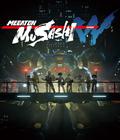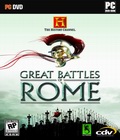Genre: Strategy
Publisher: CDV
Developer: Slitherine Software
Release Date: September 17, 2007
The History Channel: Great Battles of Rome, a historical simulation of great Roman skirmishes, takes you through a series of campaigns that spans hundreds of years. You'll fight your way through over 100 battles against various civilizations. The Roman campaign comprises the bulk of the game, but afterwards, you can play as some of the civilizations conquered by the Romans, such as the Gauls and Carthaginians. The game includes a number of famous battles, like the Battle of Cannae (216 BC), the Battle of Zama (202 BC), and the Siege of Alesia (52 BC). Great Battles of Rome also features famous historical figures of the Roman Empire, like Julius Caesar, Scipio, and Trajan.
The initial campaign is a tutorial which features the Latins, the predecessors of the Romans, and the structure is pretty linear in the 13 remaining campaigns, so you'll have to progress through the battles sequentially. There are no economic, trading, or building/management mechanics to be found here — it's all about the battles. The campaigns are peppered with relevant video sequences from actual History Channel documentaries, and the game is chock-full of historical information about the Romans and the Roman era.
One of the major differences between The History Channel: Great Battles of Rome and most real-time strategy games is how you command your troops. At the beginning of each battle, you're taken to a unit setup screen where you can determine initial battle positions, formations (offensive, defensive, and balanced), and starting orders. The initial battle orders are crucial to a good battle plan, and they consist of: advance, charge, wait (short), wait (long), seek enemy, hold fire, envelop and outflank. Much of the battle seems to be decided before it even starts because it's very difficult to make adjustments once the battle has started.
The developers have implemented a system which represents the difficulty of controlling units once the battle begins. Once the fighting has begun, you're only allowed to issue so many orders at a time to your troops. The battlefield is often chaotic, and units cannot always be told exactly where to go or what to do. Your General has a command meter which is drained a little each time you issue an order during the battle. If you don't have enough points left to issue an order, then you must wait until the meter recharges.
As with most battles, you win when the enemy surrenders or flees. It's generally a better idea to break the enemy's morale because it leads to easier victories with fewer casualties, rather than eliminate all of their numbers. Throughout the game, you'll encounter a variety of terrains and climates, which contribute varying effects to the battle. Some of the maps might force you to cross a river to engage the enemy, fight uphill, or flush out an army that's hiding in a forest. These factors, in addition to enemy size and composition, should be considered when formalizing a battle plan. Spearmen are effective against cavalry, and cavalry can trample light infantry, and skirmishers can execute hit-and-run tactics against slow heavy infantry.
After each battle, you'll be taken to an army management screen where you can recruit, upgrade, heal, and promote your troops. Troops can gain upgrades like increased health, increased attack, and bonuses against specific unit types, among several others. You can also purchase equipment for your troops, and although it doesn't show up on the soldier models, it does confer bonuses to attack and defense. After every battle, you gain some money with which to buy equipment and new troops. Your fame rating is determined by victories, and it's needed to get higher-tier units and heal your existing troops. Your army can have up to 20 squads of troops in it, and for each squad, you'll have a wide variety of troop selection, including archers, infantry, elephants and just about every unit type you'd expect from this time period. There don't seem to be any siege or artillery weapons in Great Battles of Rome, but I'm playing an early preview build, so that may have changed.
As you win fights, your units will gain experience, which can be used to promote units and gain bonus stats and abilities. Hand-to-hand troops can gain extra health, bonus damage, or increased defense, to name a few. Your General can gain abilities like Strategist, which increases your command points, and Quick Thinker, which allows command points to recharge more quickly.
The graphics in Great Battles of Rome appear on par with other Slitherine titles, like Gates of Troy and Spartan, and it operates in a comparable manner, too. The battles are fought in a real-time 3D landscape where you observe from an overhead view, and the battlefield controls let you zoom in and out, pan around, and rotate your view. The soundtrack is appropriately themed for Roman battles and incorporates a number of instrumental tracks. There doesn't appear to be voice-acting for the units or mission briefings, although a narrative dialogue is spoken during the movie sequences.
The History Channel: Great Battles of Rome simulates fights with a bit more realism than other similarly themed titles like Rome: Total War. Although it may have more realism in the way of issuing orders, the gamer isn't required to use any more strategy than in the average RTS. It forgoes an overarching strategic management mode in order to detail numerous historical battles, and it has a pick-up-and-play interface so even novice strategists should be able to get a hang of it. Look for it when it hits store shelves in September.
More articles about The History Channel: Great Battles of Rome











 Merging action and strategy in a setting that replicates the atmosphere of the period, The History Channel: Great Battles of Rome allows players to take control of a series of campaigns against Barbarian hordes, while carving out the Roman Empire. The History Channel: Great Battles of Rome immerses the player into history as never before by combining cutting-edge gameplay, historical footage and battle simulation.
Merging action and strategy in a setting that replicates the atmosphere of the period, The History Channel: Great Battles of Rome allows players to take control of a series of campaigns against Barbarian hordes, while carving out the Roman Empire. The History Channel: Great Battles of Rome immerses the player into history as never before by combining cutting-edge gameplay, historical footage and battle simulation.






